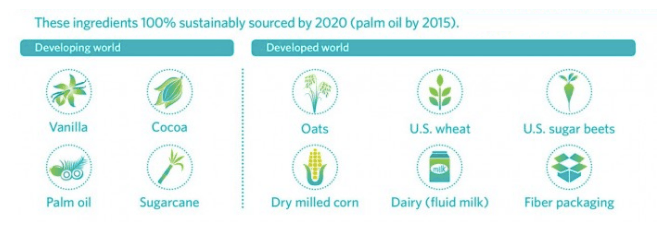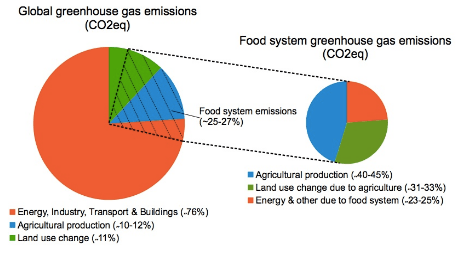Cuckoo for Climate Change: How General Mills is Tackling the Ongoing Food Crisis

How General Mills is addressing climate change.
Is your favorite breakfast cereal harming our planet? Food manufacturers are affecting the massive climate crisis threatening our world’s food supply. In fact, the food and agriculture sector is directly responsible for ~25% of global emissions [1]. The resulting extreme weather has been leading to crop failures, price gauges and reduced quality goods. Notably, our beloved food giant General Mills has taken a trailblazing stance in setting aggressive goals to reduce its environmental impact and lead the industry towards a sustainable future.
Food System Responsible For ~25% of Global GHG Emissions [3]
Stirring controversy in the food industry
As Chief Sustainability Officer Jerry Lynch stated, it’s no secret that “climate plays a significant role in the long-term viability of our business” [2]. Adverse weather has created severe droughts and floods, which have decreased General Mill’s raw material yields. In 2014, these conditions caused a ~4% loss in production [2]. Persisting climate issues have impacted commodity prices, and as a result, cereal prices are estimated to soar by at least 20% over the next 15 years [3].
Controversially, Oxfam publicly criticized General Mills and its competitors for their lack of attention to sustainability, claiming they were “accomplices of climate change.” In response, General Mills focused its efforts on its supply chain and successfully implemented sustainable practices.
How General Mills is addressing climate change
Expanding the scope of emissions reduction efforts
Last year, General Mills committed to reducing its greenhouse gas emissions by 28% across its value chain over the next 10 years [4]. Unlike competitors, General Mills used a stringent science-based approach, relying on data to determine the reduction needed to sustain our planet’s health. In order to achieve this target, General Mills looked beyond its direct operations and set standards for its upstream partners in agriculture where two-thirds of emissions occur [5]. The company reinforced its moral stance and inspired competitors to follow suit by expanding its emissions goals to include its small and large agricultural partners and industry groups [5].
Partnering to sustainably source raw materials
To ensure raw materials sustainability, General Mills committed to sustainably sourcing 100% of its ten priority ingredients by 2020 [5]. In partnership with the World Wildlife Fund and Rainforest Alliance, General Mills identified the materials it can impact most, considering risk factors from deforestation to water use. These ingredients represented over 50% of its annual raw material purchases [5]. To enforce accountability, General Mills hired auditors to measure its progress. Most recently, General Mills announced it exceeded 2015 targets, reducing its GHG emissions rate by 23% through renewable energy sources [4].
General Mills’ Sustainable Sourcing Commitment [6]

What General Mills should do next
Set more aggressive emission reductions targets to ignite industry change
As one of our largest food producers, General Mills has a moral obligation to be a leader in sustainability. Given that recent efforts have put the company on target to meet its original emissions goals, those need to be revised. General Mills should extend its 2050 emissions reduction target to 50%, the level necessary to combat global warming according to the Intergovernmental Panel on Climate Change [1]. Further, it should pressure suppliers and commodity producers to increase their targets and publicly report progress. This change is necessary as not only a political statement on the urgency of this issue but also a mitigation against the fact that agricultural emissions will likely increase by 30% by 2050 as food demand rises [1].
Invest in regenerative agriculture to support suppliers in developing economies
20% of General Mill’s raw materials are procured from developing countries and smallholder farms, which lack access to the capital and technology required to implement impactful sustainability improvements [6]. General Mills should educate those growers in regenerative agriculture techniques, which can be implemented more quickly and promote carbon storage [7]. For example, farmers could manage livestock behavior in ways beneficial to land or infuse perennial crops that prevent soil erosion. These techniques will be easier to implement than those requiring advanced monitoring technology and will allow smallholder farms to boost their climate resiliency.
Staying on the shelf
General Mills started off on the wrong side of the sustainability equation, but the company addressed criticism through action. Since then, General Mills has made impressive strides in reducing GHG emissions and addressing the effects of climate change on its business and supply chain. Still, the crippling food crisis is looming, and General Mills must leverage its position as an industry leader to continuously promote sustainable practices throughout the food industry.
As a consumer, what would you do to make sure your favorite cereal stays on the shelf?
(Word Count: 779)
Sources
[Header Image] General Mills. 2016. Cereals. [ONLINE] Available at: https://www.generalmills.com/Brands/Cereals.aspx. [Accessed 4 November 2016].
[1] OXFAM. 2014. Standing On The Sidelines. [ONLINE] Available at: https://www.oxfam.org/sites/www.oxfam.org/files/file_attachments/bp186-standing-sidelines-big10-climate-emissions-200514-summ-en_0.pdf. [Accessed 4 November 2016].
[2] Shannon Heine. 2015. General Mills Makes New Commitment to Climate Change. [ONLINE] Available at: http://blog.generalmills.com/2015/08/general-mills-makes-new-commitment-on-climate-change/. [Accessed 4 November 2016].
[3] James West. 2014. Climate Change Will Make These Breakfast Cereals More Expensive. [ONLINE] Available at: http://www.huffingtonpost.com/2014/05/20/climate-change-breakfast-cereals_n_5358353.html. [Accessed 4 November 2016].
[4] General Mills. 2015. Reducing GHG Emissions. [ONLINE] Available at: https://www.generalmills.com/en/Responsibility/Environment/environment-approach/reducing-ghg-emissions. [Accessed 4 November 2016].
[5] General Mills. 2014. Policy on Climate. [ONLINE] Available at: https://www.generalmills.com/News/Issues/climate-policy. [Accessed 4 November 2016].
[6] General Mills. 2016. Global Responsibility. [ONLINE] Available at: https://globalresponsibility.generalmills.com/HTML1/general_mills-global_responsibility_2016_0039.htm. [Accessed 4 November 2016].
[7] Andrew Winston. 2016. How General Mills And Kellogg Are Tackling Greenhouse Gas Emissions. [ONLINE] Available at: https://hbr.org/2016/06/how-general-mills-and-kellogg-are-tackling-greenhouse-gas-emissions. [Accessed 4 November 2016].




As one of the largest food producers in the U.S., General Mills should set the tone for how sustainability can succeed in the food industry. You mentioned that General Mills not only set emission reduction standards for itself, but it also set standards for upstream partners. I’m curious how this is actually enforced in practice – are there emissions “auditors” that measure whether these partners are actually meeting sustainability targets? Self-reported metrics may not always be accurate, particularly if the shift to sustainability is costly.
I’m also curious whether General Mills wanted to take it one step further and vertically integrate with their farmers, particularly those in developing countries that lack capital and technology. General Mills could provide capital, technology, and education for these growers, and in return have a more stable, sustainable supply of raw materials in the future.
Interesting post. I agree that General Mills is making positive headway on its sustainable sourcing practices for its upstream supply chain.
However, it seems to me that General Mills may be overly focused on sustainable sourcing, while ignoring some of the inefficiencies in its downstream supply-chain. Packaging, for example, represents 14% of the total greenhouse gas emissions across the value chain and is not explicitly addressed in General Mills’ sustainability report (https://www.theguardian.com/sustainable-business/2015/oct/23/general-mills-sustainable-supply-chain-un-climate-conference-paris).
Since consumers actually interact with General Mills when they buy a package of cereal in the store, it seems odd to not focus in this area. Per the General Mills website, the company seems to indicate that is has already addressed packaging and there are no specific goals going forward (https://www.generalmills.com/en/Responsibility/Environment/environment-approach/Packaging). I would worry about complacency in this area as downstream supply chain is still a very material percentage of the company’s GHG emissions.
Thank you for writing an interesting, clear blog post Elyse!
GM is setting ambitious targets and is currently on track to deliver – that’s indeed quite impressive. I second the comment about considering the environmental impact on other parts of the chain than sourcing. Another topic I find interesting for GM is how the company will react to the growing concerns about GMOs in our food.
While GMOs are a heated topic, an abundance of research finds that GMOs significantly increase farm yields, while decreasing pesticide use and soil erosion – a net positive for the environment (e.g., see this large study from the National Academy of Sciences http://www.nap.edu/download.php?record_id=12804#). Hence, the “non-GMO” trend could be deteriorating to our environment. However, General Mills just recently in March 2016 stated labelling its products with a GMO label. I’m curious to see whether GM will stand firm to its GMO use and take an active role in educating the public about the environmental benefits of GMO or if GM will bow to the demands of its customers.
Great post – it is really encouraging to see how proactive GM has been with introducing sustainable practices throughout its supply chain. I know GM has also been a leader in the food safety space, especially with its cereals (e.g., taking artificial colors out of its kids cereals), to respond to declining consumption metrics. I wonder what impact their sustainably sourced raw materials will ultimately have on price – while it is an admirable practice, I worry that consumers might not be willing to pay more for this benefit. Will be interesting to see how both approaches play out in the future!
I like how you point how that they take a methodical approach to resolving the issue and go through what will make the most impact. Sometimes we may just want to do what is easiest or quickest, but we will now push ourselves to get some appropriate data.
Well-written post, Elyse. I agree with your conclusions that there is much General Mills (GMs) can do to increase it’s sustainability, which you argue is GM’s obligation from a corporate moral perspective, customer expectation, and industry leadership position.
Beyond sustainability, I would also argue that General Mills will have many challenges posed to its operations by climate change, such as:
– Cost of growing food (raw materials) with the increase in droughts, severe weather, and increasing ambient temperatures
– Potential future regulations imposing greenhouse gas emissions caps, impacting their manufacturing processes
– Social pressure creating competition for land use between natural habitat and agriculture
These topics may be of interest for a future post.